Catocala unijuga
Catocala unijuga
kah-TOCK-uh-lahMewe-nih-JOO-guh
Walker, [1858]
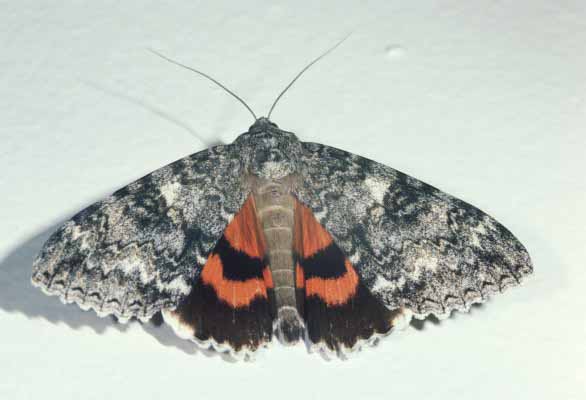
Catocala unijuga August 15, 1983, Ann Arbor, Michigan,
© Donald H. Gudehus
This site has been created by
Bill Oehlke at oehlkew@islandtelecom.com
Comments, suggestions and/or additional information are welcomed by Bill.
| TAXONOMY:
Superfamily: Noctuoidea
Family: Noctuidae
Group: Noctuinina
Subfamily: Catocalinae
Genus: Catocala, Schrank, 1802
|
DISTRIBUTION:
Catocala unijuga, The Once Married
Underwing, (wingspan: 65mm (Ray)-70-90mm) flies across
Canada (rare in
Newfoundland) from British Columbia to Prince Edward Island,
including Alberta, Saskatchewan, Manitoba, Ontario, Quebec, New Brunswick, Nova Scotia, south through
New Hampshire, Connecticut
and west to
Montana, Minnesota and Colorado.
Dr. Wayne H. Whaley reports C. unijuga flies in Utah in
August within the Wasatch Mountains nr. Provo Cyn and northward into
Idaho. Carroll Rudy sent the following image from
Wisconsin.
It has also been confirmed in
District of Columbia, Iowa,
Illinois,
Indiana,
Kentucky,
Maryland (Cambridge, Dorchester County, Jonathan Willey),
Massachusetts,
Maine,
Michigan,
Missouri,
North Dakota,
Nebraska,
New Jersey,
Nevada,
New York,
Ohio,
Pennsylvania,
Rhode Island,
South Dakota,
Virginia,
Vermont,
West Virginia and
Wyoming.
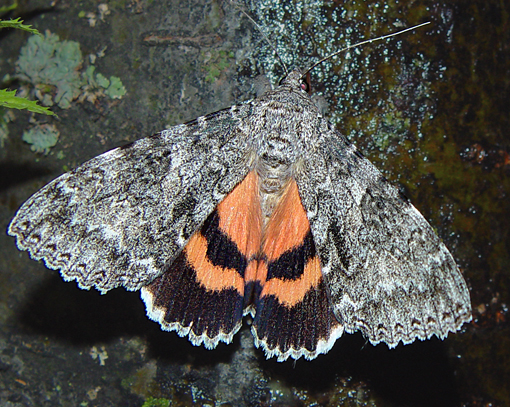
Catocala unijuga, courtesy of Carroll Rudy, Calumet County, Wisconsin,
August 26, 2006, id confirmed by Larry Gall.
Scott Shaw reports unijuga is taken (not common)
"on Pole Mountain, in the Medicine
Bow Forest, Wyoming, about 10 miles east of Laramie near I-80 in
the mountain willow bogs."
Visit Catocala unijuga, July 3, 1998; Forest Hills, Allegheny Co., Curt Lehman;
Visit Catocala unijuga, Windsor, Ontario, Canada, courtesy of Maurice Bottos.
Visit Catocala unijuga male, recto and verso, Regina, Saskatchewan, Canada, July 29, 2009,
courtesy of Tim Taylor, Saskatchewan Collection.
Visit Catocala unijuga form agatha, male, recto and verso, Regina, Saskatchewan, Canada, August 22, 2009,
courtesy of Tim Taylor, Saskatchewan Collection.
Visit Catocala unijuga, Sidney, Kennebec County, Maine, August 14, 2011, Steve Lemieux.
Visit Catocala unijuga, Cambridge, Dorchester County, Maryland, September 6, 2015, Jonathan Willey.
Visit Catocala unijuga, Worthington, Nobles County, Minnesota, September 16-19, 2011, Tom Middaugh.
There is a melanic
form,"agatha", Beutenmuller, whose forewings are a dark, smoky grey.
The aberration "fletcheri", Beutenmuller has hindwings which are
entirely black.
John Acorn confirms C. unijuga from Redcliff, Alberta,
Canada.
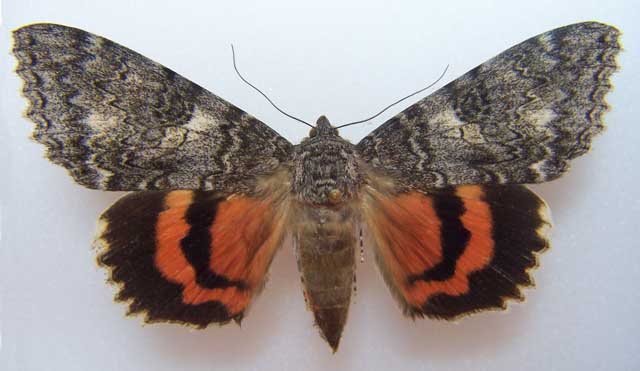
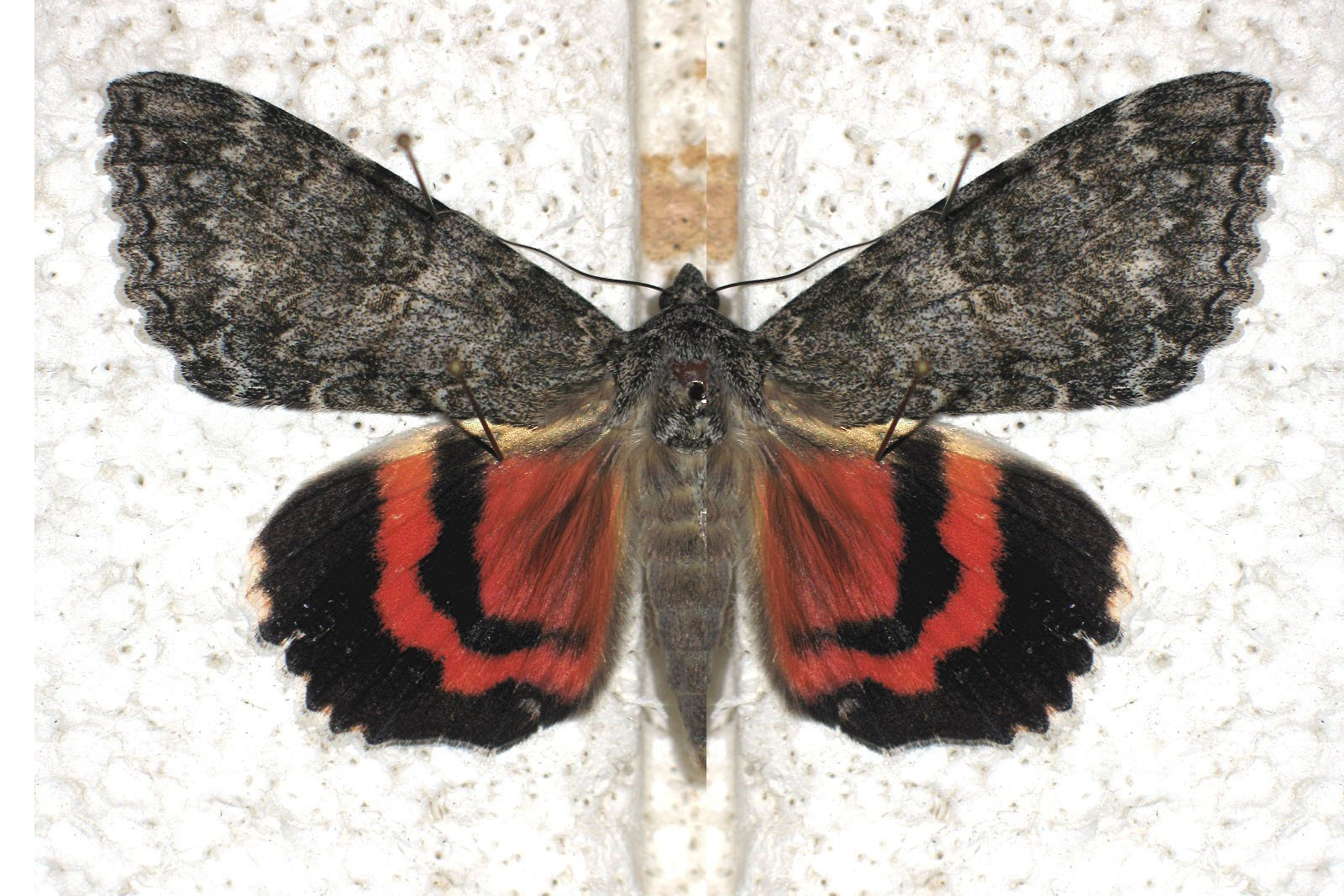
Catocala unijuga bait, Mason, Ingham County, Michigan,
80mm, July 14, 1994, courtesy of Harry King
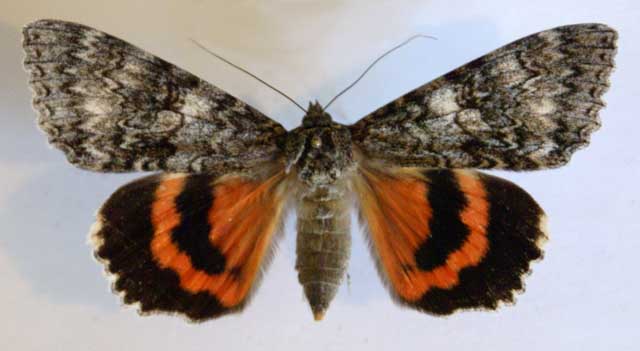
Catocala unijuga female, Regina, Saskatchewan,
77mm, August 18, 2009, courtesy of Tim Taylor
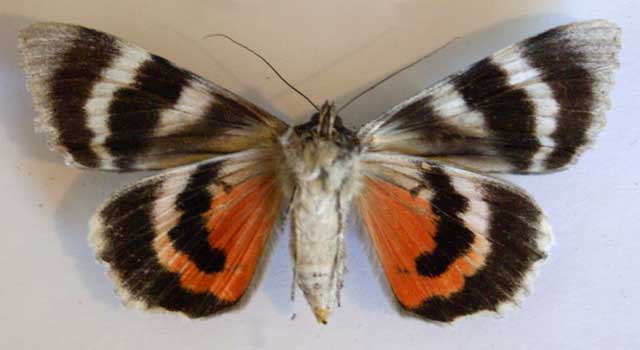
Catocala unijuga female (verso), Regina, Saskatchewan,
77mm, August 18, 2009, courtesy of Tim Taylor
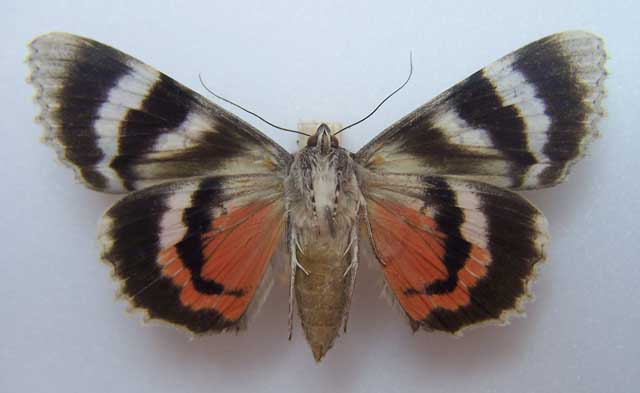
Catocala unijuga bait (verso), Mason, Ingham County, Michigan,
80mm, July 14, 1994, courtesy of Harry King
I sometimes have difficulty distinguishing this
species from the generally smaller Catocala semirelicta,
especially in those semirelicta specimens lacking the diffuse dark
bar just above the forewing
inner margin. Usually there is a large pale patch on the body side
of the reniform spot in C. unijuga.
C. unijuga courtesy of Jim Vargo. | 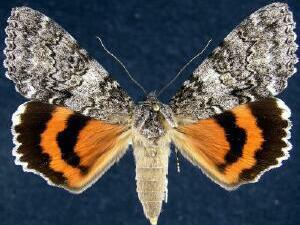 |
Generally C. unijuga has a greyer forewing with not quite as
much contrast. The subreniform spot is closed (open in semirelicta),
and the tooth just below the longest tooth in the pm line is more
reduced in unijuga than it is in semirelicta. C. unijuga also seems to lack
the yellowish scales in the subreniform spot and outside the pm line.
In unijuga the hindwing inner black band is thicker and almost reaches the inner margin.
Many thanks to Ray who provides the following images of a small (65mm) Catocala unijuga from northwestern Massachusetts.

Catocala unijuga, 65 mm, NW Massachusetts, id confirmed by Larry Gall,
courtesy of Ray.

Catocala unijuga, 65 mm, NW Massachusetts, id confirmed by Larry Gall,
courtesy of Ray.
FLIGHT TIMES AND PREFERRED FOOD PLANTS:
Catocala unijuga are usually on the wing from late June
(Indiana) through July, August and September
to early October (Quebec).
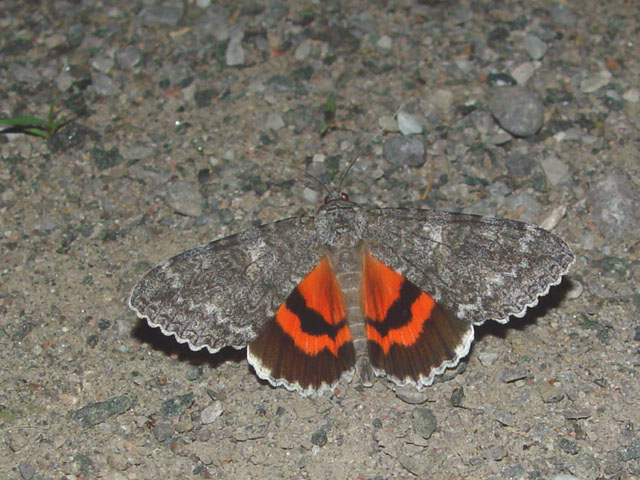 :
:
Catocala unijuga, (form agatha) Peterborough, Ontario,
July 12, 2005,
courtesy of Tim Dyson, form id by Larry Gall.
This species probably has one of the longest flight periods of all
the Catocala but is still believed to be univoltine
(single brooded).
Larvae feed on cottonwoods, poplars and willows.
Adults come to lights and to bait and can sometimes be "caught with a
flashlight" while nectaring on joe-pye-weed (pond or stream edges),
milkweed (open fields, roadsides) or other nectar sources.
They often rest high on tree trunks with head up. Image courtesy of
Tim Dyson, July 27, 2006.
| 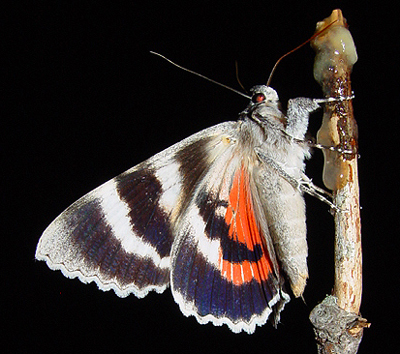 |
ECLOSION:
Adults eclose from pupae at soil surface.
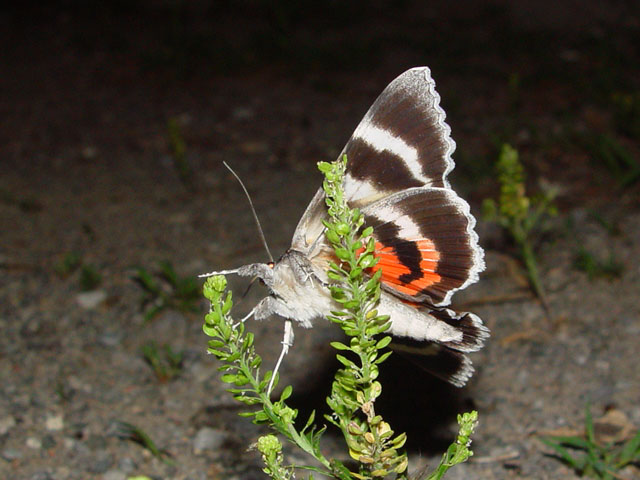 :
:
Catocala unijuga, (form agatha) Peterborough, Ontario, July 12, 2005, courtesy of Tim Dyson.
SCENTING AND MATING:
Catocala unijuga females
emit an airbourne pheromone and males use their antennae to track the
scent plume.
EGGS, CATERPILLARS, COCOONS AND PUPAE:
Eggs are deposited on
tree bark in the fall and hatch the following spring.
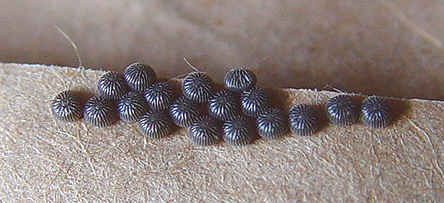
Catocala unijuga eggs, courtesy of Tim Dyson.
copyright
The dark grey larvae attain lengths of 50 mm. The middorsal stripe is
very irregular and pale, and the head has black side stripes broadly
connected across the vertex.
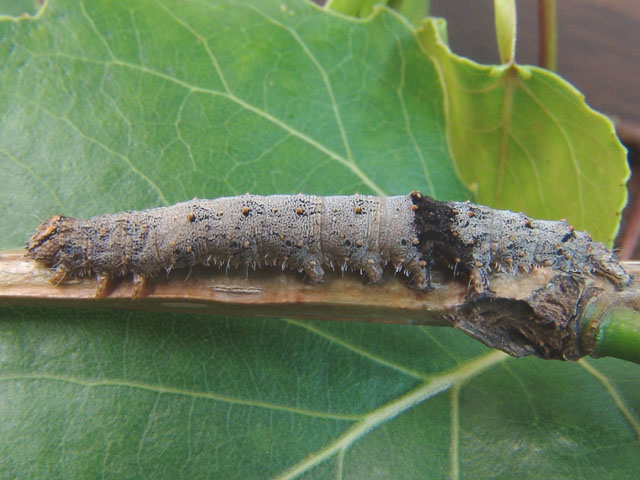
Catocala unijuga fourth instar, courtesy of Gabriel Larrabee.
copyright
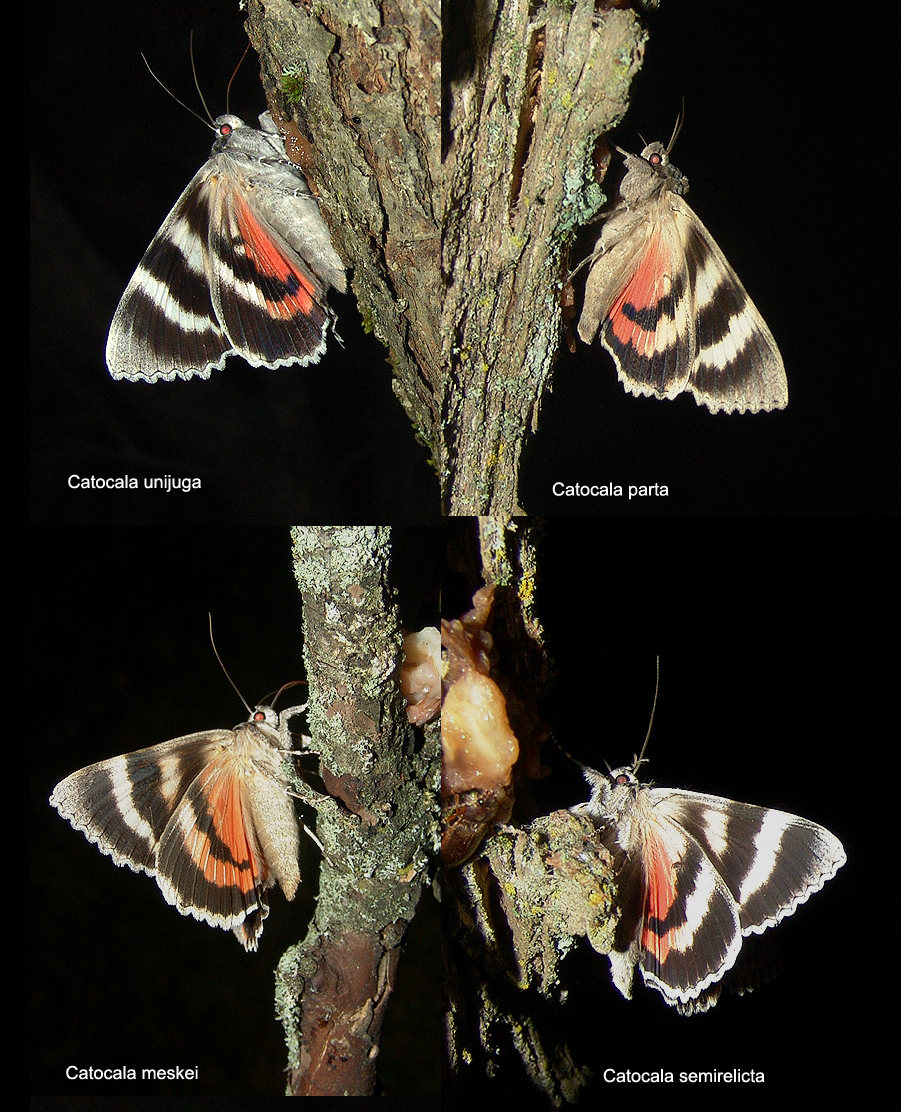
Catocala comparison Plate, Peterborough, Ontario,
courtesy of Tim Dyson.
Note strong presence of discal lunule in both unijuga and semirelicta.
Note very dentate nature of inner edge of outer black band on both the forewing and hindwing of parta.
The discal lunule is also very weak in parta, compared to other similar species.
Larval Food Plants
Listed below are primary food plant(s) and alternate food plants.
It is hoped that this alphabetical listing followed by the common
name of the foodplant will prove useful. The list is not exhaustive,
although some species seem very host specific.
Experimenting with closely related foodplants is worthwhile.
Populus tremuloides.....
Populus nigra
Salix
|
Quaking aspen
Lombardy Poplar
Willow
|
Use your browser "Back" button to return to the previous page.
Return to Main Index
Visit additional Catocala unijuga
images.
Visit Catocala unijuga, Thornton, Grafton County, New Hampshire, August 31, courtesy
of Deb Lievens.
Use your browser "Back button to return to the previous page.
Goto Main Catocala Index
This page is brought to you by Bill Oehlke and the
WLSS. Pages are on space rented from Bizland. If you would like to become a "Patron of the Sphingidae/Catocala Sites",
contact Bill.
Please send sightings/images to Bill. I will do my best to respond to requests for identification help.
Enjoy one of nature's wonderments: Live Saturniidae (Giant Silkmoth) cocoons.

|

To show appreciation for this site, click on the flashing
butterfly to the left, a link to many worldwide insect sites. |
Tom Middaugh recently sent me a "plate" of three specimens, tentatively identified by himself as
Catocala unijuga, but with a question of
possibility of them being Catocala semirelicta.
I replied:
"Hi Tom,
"I would go with unijuga even though they are on small side of wingspan range.
Reasons:
1) black median band on hindwing almost reaches the inner margin; I expect it to be more distant in semirelicta;
2) there are some dark hairs in basal median area of hindwings on all three specimens, typical of unijuga; I expect a “clearer complexion” in semirelicta
(no blackish grey hairs in hindwing basal median areas) This is my primary reason;
3) semirelicta usually have a lighter overall appearance to forewing ground colour, less contracting than in unijuga;
4) absence of diffuse dark bar on forewing, paralleling the inner margin, usually present in semirelicta, reduced to thick outline along inside of last
inward projection on unijuga.
"I have also been told by Harry Dale King, who is quite knowledgable, that wingspan of semirelicta is usually more in 55mm range in Michigan.
I wish permission to post them, credited to you, from a link on unijuga page?"
After posting this reply to Tom, I also posted the "plate" to both the semirelicta page and to the unijuga page, and I noticed an additional character which seems
fairly consistent:
In semirelicta, there seems to be, in the marginal area of the forewing outer margin, moving from body to outer wing edge,
1) thick black arcs, not extending to wing veins between each pair of veins, 2) atop small whitish circles outlined in black except for outer edge of circles, 3)
atop thin black arcs that
run from wing vein to wing vein.
In unijuga, in the same respective areas, the 1) internal cap is thinner and almost reaches wing veins, 2) the outer circles are less distinct and greyish,
3) the outer, thinner arcs are common to both species. I do not know if this feature is consistent, but if present with other characters mentioned above,
it will add additional confidence in determining the two species.
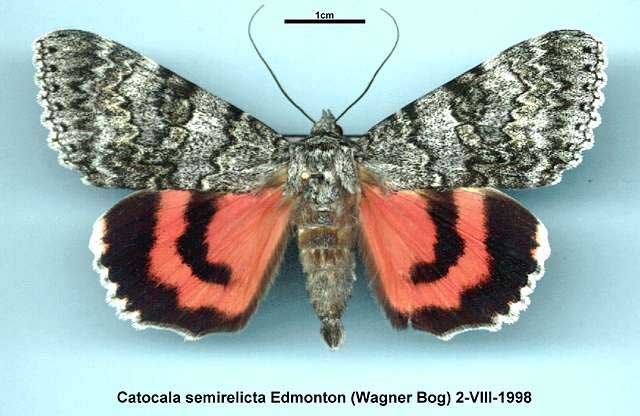
Catocala semirelicta, Wagner Bog, edmonton, Alberta, August 2, 1998, SEM.










 :
:
 :
:




